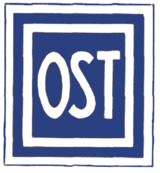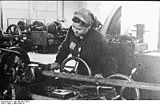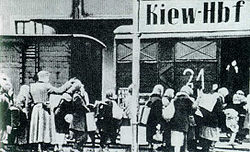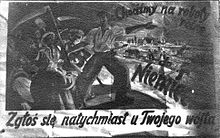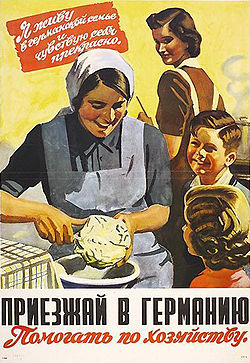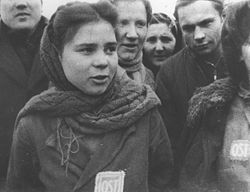- OST-Arbeiter
-
OST-Arbeiter (German: Ostarbeiter, English: Eastern Workers) was a designation for slave workers gathered from Eastern Europe to do forced labor in Germany during World War II. The Ostarbeiters were mostly from the territory of Reichskommissariat Ukraine (eastern Ukraine). Ukrainians made up the largest portion although many Belarusians, Russians, Poles and Tatars were also present.[1] Estimates put the number of OST-Arbeiters between 3 million and 5.5 million.[2] Some estimates place the number as high as 8.5 million workers.[who?]
Most were very young, under the age of 16, as those older than 16 were usually conscripted. 30% were as young as 12–14 years of age when they were taken to Germany.[2] By November 1943 the age limit was dropped to 10.[2] 50% of those taken from Ukraine were girls and women.
OST-Arbeiters from Reichskommissariat Ukraine were forced to wear a dark blue and white badge with "OST", the German word for East.
Contents
Terminology
The official German records for the late summer of 1944 listed 7.6 million foreign civilian workers and prisoners of war in the territory of the "Greater German Reich", who for the most part had been brought there for employment by force.[3] Thus, they represent roughly a quarter of all registered workers in the entire economy of the German Reich at that time.[3]
A class system was created amongst the "Fremdarbeiter" [foreign workers] brought to Germany to work for the Third Reich. The multi-layered system was based on layers of national hierarchies.
- Gastarbeitnehmer
- guest workers
- Germanic, Scandinavian and Italian workers.
- guest workers
- Zwangsarbeiter
- forced workers
- Militärinternierte
- military internees
- Primarily POWs
- military internees
- Zivilarbeiter
- civilian workers
- Primarily Polish prisoners from the General Government - They received lower wages and food rations; had to work longer hours than Germans; could not use public conveniences (from public transport to restaurants or churches); possessions of certain items was forbidden; and were required to wear a sign - the "Polish-P" - attached to their clothing.
- civilian workers
- Ostarbeiter
- Eastern workers
- Eastern worker were primarily from "Reichskommissariat Ukraine". They were marked with a sign OST ("East") and were subject to even harsher conditions than the civilian workers. They were forced to live in special camps that were fenced with barbed wire and under guard, and were particularly exposed to the arbitrariness of the Gestapo and the commercial industrial plant guards. At the end of the war 5.5 million Ostarbeiters were returned to the USSR.[3]
- Eastern workers
History
Preamble
Nazi Germany faced a crisis at the end of 1941 because after it had mobilized its massive armies, a shortage of workers developed in Germany to support the war industry. Hermann Göring initially thought "the best thing would be to kill all men in Ukraine over fifteen years of age" but then realized working them to death was more beneficial for the Third Reich. To help overcome this shortage of labour Göring decided to bring in people from the recently seized territories of eastern Europe, primarily Ukraine, to work in German war industries. These workers from "Reichskommisariat Ukraine" were called Ostarbeiters (east workers).[4]
Voluntary recruitment
Initially a recruiting campaign was launched in January 1942 by Fritz Sauckel for workers to go to Germany. "On January 28 the first special train will leave for Germany with hot meals in Kiev, Zdolbunov and Przemyśl" offered an announcement. The first train was full when it departed from Kiev on January 22.
The advertising continued in the following months. "Germany calls you! Go to Beautiful Germany! 100,000 Ukrainians are already working in free Germany What about you?" ran a Kiev newspaper ad on March 3, 1942.
Word got back however, of the sub-human slave conditions that Ukrainians met in Germany and the campaign failed to attract sufficient volunteers. Forced recruitment and forced labor were implemented,[4] although propaganda still depicted them as volunteers.[5]
Forced recruitment
With the news about the terrible conditions many Ostarbeiter faced in the Third Reich the pool of volunteers soon dried up. As a result, the Germans were forced to resort to mass round-ups, often using the ploy of targeting large gatherings such as church congregations and crowds at sporting events, with entire groups simply marched off at gunpoint to waiting cattle trucks and deported to Germany.[6]
Reichskommissar Erich Koch was ordered to provide 450,000 workers a year from Ukraine for German industry by "ruthless" means. German documents stated that the Ukrainian Ostarbeiter would be "worked to death." Although 40,000 Ukrainians a month were being sent to Germany as Ostarbeiters, armaments minister Albert Speer complained that his work force was dwindling. (This could be understood to indicate that more than 40,000 were dying every month.)[7]
In one memorandum from Fritz Sauckel to Alfred Rosenberg there was a demand for one million men and women in four months at the rate of 10,000 a day and more than two-thirds were to come from Ukraine. In all the major Ukrainian cities the German army kidnapped young adults off the streets and shipped them to Germany as virtual slave laborers to work in the worst and most dangerous conditions. On the orders of the German administration Ukrainian cities were to be permanently depopulated by starvation and deportation.[7]
Nannies
One special category was that of young women recruited to act as nannies; Hitler argued that many women would like to have children, and many of them, were restricted by the lack of domestic help.[8] (This was one of many efforts made to promote the birth rate.[9]) Since the nannies would not only be in close company with German children but also in a position where they might be sexually exploited, they were required to be suitable for Germanization.[10] Himmler spoke of thus winning back German blood and benefiting the women, too, who would have a social rise through working in Germany and even the chance to marry there.[8] They could be assigned only to families with many children who would properly train the nannies as well.[8] These assigments were carried out by the NS-Frauenschaft.[11]
Originally, this was carried out only in the annexed terriorities of Poland, but the lack of women who passed screening extended it to all of Poland, and also to occupied territories in USSR.[10]
On September 3, 1942 Hitler demanded that half a million Ukrainian women be brought to Germany to free German women from housekeeping. These women were recruited Hitler thought there was a Germanic strain in Ukraine because the Ostro-Goths and Visi-Goths had lived in southern Ukraine 1,800 years earlier and the "chaste peasant virtues of Ukrainian women" appealed to him. Only about 15,000 girls were taken to Germany to work as domestics.[7]
Conditions
In Germany OST-Arbeiters lived in both private camps owned and managed by the large companies, and special camps guarded by privately paid police services known as the Werkschutz.
They worked an average of 12 hours a day, six days a week.
The pay was approximately 30% of a German worker however, most of the money went toward food, clothing and board. The labor authorities complained that many firms viewed these former Soviet civilian workers as "civilian prisoners", treated them accordingly, and paid no wages at all to them.[3] Those that were paid were paid with specially printed paper money and savings stamps, which could only be used toward the purchase of limited number of items in special camp stores. By law, they were given worse food rations than other forced labor groups. Starvation rations and primitive accommodation were given to these unfortunates in Germany.
 OST Arbeiter savings stamps. Like cash but not much could be bought with them; redeemable for goods in Reichskomisariat Ukraine (maybe)
OST Arbeiter savings stamps. Like cash but not much could be bought with them; redeemable for goods in Reichskomisariat Ukraine (maybe)
OST Arbeiters were forced to wear a badge OST (East) on their clothes at all times.
The Ostarbeiters were restricted to their place of residence (in some cases labor camps) and forbidden to fraternize with Germans. They were regarded as subhuman, and were ordered to be kept separated from the German population. The Germans considered the Ukrainians Untermensch (sub-humans) "inferior humans" who could be kicked, beaten, terrorized and killed at their least transgression. Those who tried to escape were hanged where other workers could see their bodies. Leave without authorization or escape was punished by death.[1] All sexual relations, even those that did not result in pregnancy, were severely punished[12] as Rassenschande or racial pollution.
Many died when the factories that they were employed were bombed during Allied bombing raids. Many also perished because the German authorities ordered that "they should be worked to death".
Nazi authorities attempted to reproduce such conditions on the farm, where farmers were ordered to integrate the Eastern workers into their workforce while enforcing total social separation, including not permitting them to eat at the same table, but this proved far more difficult to enforce.[13] Sexual relationships in particular were able to take place despite efforts to raise German women's "racial consciousness".[14] When the war condition worsened, these workers' conditions often improved as the farmers tried to protect themselves against a defeat.[15]
Few were able to get released and return to Ukraine to tell their story. Cases are known where girls had chopped off their fingers in a machine in order to get back home.
Statistics
 Ukrainians from Cherkashchyna being deported to Nazi Germany to serve as a slave labor force, 1942
Ukrainians from Cherkashchyna being deported to Nazi Germany to serve as a slave labor force, 1942
During the German occupation of Eastern Europe in World War II (1941-44) over 3 million people were taken to Germany as OST Arbeiters. Some estimates put the number up to 5.5 million.[2]
Between two-thirds and three-quarters of the over 3,000,000 Ostarbeiter were Ukrainians. Prof. Kondufor's statistic is that 2,244,000 Ukrainians were forced into slave labor in Germany during World War II. Another statistic puts the total at 2,196,166 for Ukrainian Ostarbeiter slaves in Germany (Dallin, p. 452).
Both of these statistics probably do not include the several hundreds of thousands of Ukrainians from Halychyna, so a final total could be about 2.5 million.[4]
Work and employment
There were slightly more women than men Ostarbeiters. They were employed in agriculture, mining, manufacturing armaments, metal production and railroads.[4]
OST-Arbeiters were initially sent to intermediate camps, where laborers were picked out for their assignments directly by representatives of labor-starved companies. Ford-Werke in Cologne and Opel in Russelsheim and Brandenburg each employed thousands of such "Ostarbeiter" at their plants.
Some OST-Arbeiters worked for private firms although many were employed in the factories making armaments. These factories were prime targets for Allied bombing. The OST-Arbeiters were considered to be quite productive and efficient. Males were thought to be the equivalent of 60-80 % of a German worker, and women — 90-100%.
Two million Ukrainians worked mostly in the armaments factories including the V-2 rocket factory at Peenemünde.[4]
Pregnancy
See also: Ausländerkinder-PflegestätteTo prevent violations of German racial laws, the workers were to be recruited in equal numbers of men and women, so brothels would not be needed,[16] but women who became pregnant were less effective workers. The original policy, sending them home,[1] created an incentive for women to become pregnant. As a consequence, contrary to the usual Nazi law against abortions, they could be aborted, even against their will.[17]
However, if the woman and the baby's father were "of good blood", the child might likewise prove "racially valuable." Consequently, the parentage was investigated, and both parents tested. If they passed, the woman would be permitted to give birth, and the child removed for Germanization.[17] If the woman was found particularly suitable, she might be removed to a Lebensborn institution.[17] If the born children did not pass, they would be removed to an Ausländerkinder-Pflegestätte, where many died to the lack of food.[18]
This was more difficult to enforce in rural areas, and authorities found that German farm wives cared for such children born to their workers alongside their own children.[19] Attempts even there were made to segregate the children and use ruthless propaganda to establish that if a worker of "alien blood" gave birth in Germany, it meant immediate and total separation from the child.[20]
Repeated efforts were made to propagate Volksturm, racial consciousness, to prevent sexual relations between Germans and foreign workers.[21]
OST Arbeiters and medical experiments
On September 6, 1944 the Reichsminister of the Interior ordered the establishment of special units for "Ostarbeiter" in several psychiatric hospitals in the Reich. The reason given was that: "With the considerable number of "Ostarbeiter" who have been brought to the German Reich as a labour force, their admission into German psychiatric hospitals as mentally ill patients has become more frequent ... With the shortage of space in German hospitals, it is irresponsible to treat these ill people, who in the foreseeable future will not be fit for work, for a prolonged period in German institutions."
The exact number of "Ostarbeiter" killed in these psychiatric institutions is as yet not known. 189 "Ostarbeiter" were admitted to the "Ostarbeiter" unit of the Heil- und Pflegeanstalt Kaufbeuren; 49 died as a result of the starvation diet, or from deadly injections.[22]
Repatriation
After the War many of the Ost Arbeiters were initially placed in DP (displaced person) camps where they were then moved to Kempten for processing and returned to their country of origin, primarily to the USSR. The Soviets also used special Agit brigades to convince many OST-Arbeiters to return.
Many OST-Arbeiters were still children or young teenagers when they were taken away and wanted to return home to their parents. Others who became aware of or understood the postwar political reality declined to return. Those in the Soviet occupational zones were returned automatically. Those in the French and English zones of occupation were forced to return, and after the signing of the Yalta Agreement which stated that "Citizens of the Soviet Union and of Yugoslavia were to be handed over to their respective countries, regardless of their consent".
In October 1945 General Eisenhower banned the use of force in repatriation in the American Zone. As a result many began to escape to the American Zone. Some, when faced with return to Soviet reality chose to commit suicide.[4]
On return to the Soviet Union OST-Arbeiters were often treated as traitors. Many were transported to far off locations in the Soviet Union and were denied basic rights and the chance to get further education.[1] Nearly 80 per cent of [Russian workers and prisoners of war returning from Germany] were sent to forced labour, some given fifteen to twenty-five years of 'corrective labour', others sent off to hard labour; all were categorized as 'socially dangerous'.[23]
Those who returned home were also physically and spiritually broken; moreover, they were considered by the authorities as having "questionable loyalty", and were therefore discriminated against and deprived of many of their citizenship rights.
OST Arbeiters suffered from state-sanctioned stigmatisation, with special references in their passports (and the passports of children and relatives) mentioning their time in Germany during the war. As a result many jobs were off-limits to anyone unlucky enough to carry such a status, and during periods of repression former slave labourers would often be ostracised by the wider Soviet community. Many victims have testified that since the war they have suffered a lifetime of abuse and suspicion from their fellow countrymen, many of whom have accused them of being traitors who helped the Germans and lived comfortably in the Third Reich while Ukraine burned.[6]
When applying for jobs, travel abroad or for certain other, politically sensitive activities which needed sanction by the Party authorities or the KGB, people had to fill out questionnaires (ankety). If a person was deemed to be of "wrong" nationality or "past", their chances of travel or work (and certain areas of study) were restricted[citation needed]
In extreme cases, some workers, when returned to the Soviet Union after the war, were incarcerated in Gulags and some were executed as collaborators.[citation needed]
Pensions and retribution
In 2000 the Foundation "Remembrance, Responsibility and Future", a project of the German Federal Government and 6,500 companies of the German Industry Foundation Initiative, was established, which spent 10 billion Deutsche Mark (5.1 billion €) to the former forced laborers. This is roughly € 2,000 per worker, much less than the inflation adjusted value of their work. Of the over 2 million Ost-arbeiters in Ukraine[citation needed] 467,000 received an amount of in total € 867 million[24], with each being assigned a one time payment of 4,300 marks. Much of this money however did not make it to its proper destination and the OST-Arbeiters were once again cheated.[25][clarification needed]484,000 recipients in Poland received € 979 million.[24]
The last payments were made in 2007.[24]
Research
Published eyewitness accounts of the Ukrainian Ostarbeiter experience are virtually non-existent in Ukraine although there were 2,244,000 of them from Ukraine according to historian Yuri Kondufor. A total of 3,000,000 Ostarbeiters were taken to Germany and it is estimated that Ukrainians constituted about 75% of the total. Ukraine, according to some sources, lost about 10 million people in World War II which was one of the greatest losses of any country in the war.[4]
Some Ostarbeiters survived the war and emigrated to the West, primarily to the United States, although a handful also made it to Australia, Canada and Brazil. Ostarbeiters who found themselves in the British or French zones were automatically repatriated. Only those who were in the American zone were not forced to return back to their countries of origin. In comparison Ukrainians from Western Ukraine and the Baltic region were not forced to return to the Soviet Union because the UK did not recognize those territories as part of the USSR.
In 1998 only two Ostarbeiters had been located in Canada for interviews for the audio and video archives of the Ukrainian Canadian Research & Documentation Centre in Toronto.
Recently a film was made by Ukrainian television focusing on the plight of the Ukrainian Ostarbeiters who returned to the Soviet Union demonstrating the harsh and inhumane treatment that they continued to receive after their repatriation.[citation needed]
Culture
Ukrainian-Canadian poet Yar Slavutych wrote an epic duma about Kempten, the camp from which Ukrainian OST-Arbeiters were processed for repatriated to the Soviet Union. The poem was set to music by Hryhory Kytasty for soloist, male chorus and symphony orchestra accompaniment. It was first performed in Washington in 1959.
See also
- Deutsche Wirtschaftsbetriebe
- Generalplan Ost and the Hunger Plan: other aspects of Nazi plans to use and abuse eastern Europe
- Hiwi
- Nazi crimes against Soviet POWs
- Untermensch
- Kidnapping of Polish children by Nazi Germany
- Victims of Yalta
- Zivilarbeiter
- Heu-Aktion
- Girl No. 217
References
- ^ a b c d (Russian) Павел Полян - Остарбайтеры
- ^ a b c d (Russian) Остарбайтеры
- ^ a b c d The Army of Millions of the Modern Slave State: Deported, used, forgotten: Who were the forced workers of the Third Reich, and what fate awaited them? by Ulrich Herbert
- ^ a b c d e f g Andrew Gregorovich - World War II in Ukraine
- ^ Europe at Work in Germany "Background"
- ^ a b Challenging WWII Taboos
- ^ a b c Largest Holocaust Archives In The World, In Bad Arolsen Germany, To Be Opened And Fully Digitized For World-Wide On-Line Study
- ^ a b c Lynn H. Nicholas, Cruel World: The Chilren of Europe in the Nazi Web p256, ISBN 0-679-77663-X
- ^ Richard Grunberger, The 12-Year Reich, p 237, ISBN 03-076435-1
- ^ a b Nicholas, p. 255
- ^ Richard Grunberger, The 12-Year Reich, p 258, ISBN 03-076435-1
- ^ Robert Edwin Hertzstein, The War That Hitler Won p139 ISBN 399-11845-4
- ^ Richard Grunberger, The 12-Year Reich, p 165, ISBN 03-076435-1
- ^ Leila J. Rupp, Mobilizing Women for War, p 125, ISBN 05109-7
- ^ Richard Grunberger, The 12-Year Reich, p 166, ISBN 03-076435-1
- ^ Nicholas, p. 399
- ^ a b c HITLER'S PLANS FOR EASTERN EUROPE
- ^ Nicholas, p. 400-1
- ^ Nicholas, p. 402
- ^ Nicholas, p. 403
- ^ Robert Edwin Hertzstein, The War That Hitler Won p139 ISBN 399-11845-4
- ^ Forced Labourers in Psychiatry
- ^ Rosemary H. T. O'Kane, Paths to Democracy: Revolution and Totalitarianism, Routledge, 2004, ISBN 0415314739, Google Print, p.164
- ^ a b c Press release (German)
- ^ (Ukrainian) Колиншні остарбайтери вважають, що їх обдурили
Sources
- Ukrainian - The Third road for Germans Catholics
- dokumentartheater berlin and their production "OST-Arbeiter"
- Andrew Gregorovich - World War II in Ukraine
- An Ostarbeiter's Employment Identification Document
- Reinhold Billstein (Editor) Working for the Enemy: Ford, General Motors, and Forced Labor in Germany During the Second World War - Berghahn Books (November 2000) ISBN 1571812245
Russian
Ukrainian
External links
- Europe at Work in Germany propaganda aimed at Germans about the program
Categories:- Nazi war crimes
- Forced migration
- Soviet–German War
- Unfree labor during World War II
- Gastarbeitnehmer
Wikimedia Foundation. 2010.

